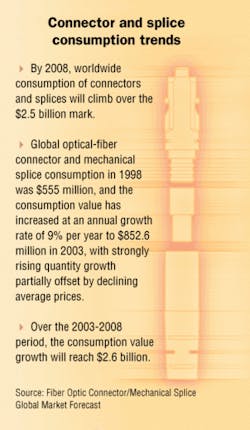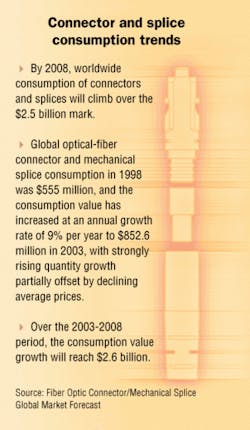The optical-fiber connector/mechanical splice market is experiencing a recovery, and demand will continue to grow in the next five years, according to a recent forecast by ElectroniCast Corp. (www.electronicast.com), based in San Mateo, CA. The study states that the recovery is being driven by dwindling inventory ,which was in turn caused by lack of production by optical-fiber connector and splice manufacturers during the past few years.
Stephen Montgomery, president of ElectroniCast, says contractors who are installing cable for end users— including companies and educational institutions—have been buying connectors and splices that may have been produced years ago. Cable assembly houses have likewise been buying up the old inventory.
"The driver is that inventory is disappearing," says Montgomery. "People are still buying the end use products that they used in previous years, but that product was not necessarily produced this year. It could have been produced in 2000."
As a result, Montgomery says manufacturers will soon have to make more, and this will fuel the recovery. "It's getting to the point where we actually are getting orders greater than we have capability for, and will be telling suppliers to make more," he says.
ElectroniCast makes its predictions in the Fiber Optic Connector/Mechanical Splice Global Market Forecast. The study looks at different types of connectors, including singlemode and multimode, simplex and multichannel/multifiber, FC, SC, ST, MU, LC and others, as well as adapters and mechanical splices.
The forecast predicts growing demand for connectors and splices, and that by 2008, worldwide consumption of connectors and splices will climb over the $2.5 billion mark.
For comparison, the report states that the global optical-fiber connector and mechanical splice consumption in 1998 was $555 million. The consumption value has increased at an annual growth rate of 9% per year to $852.6 million in 2003, with strongly rising quantity growth partially offset by declining average prices. Over the 2003-2008 period, the consumption value growth will reach $2.6 billion, according to the report.
Montgomery admits that the forecast comes at a time when much of the cabling industry remains mired in a struggling economy. "A lot of analysts don't think 2003 will be better than 2002, and an equal number say it will be worse. But 2003 will be better than 2002," says Montgomery. "We are recovering because of the increasing number of sales over the previous year."
Still, he says there are undeniable signs that this portion of the industry is facing increasing demand from different regions of the world. The report, for example, states that North America led in global consumption with 57.2% or $317.9 million in 1998. North American consumption is expected to expand in value to $1.256 billion by 2008.
The report states that North American connector consumption will be driven by the proliferation of relatively shorter links used in private data and local loop networks. European connector consumption, 22.8% in 2003, is led by the European Union member states as they transition to open competition in delivery of broadband services to business, as well as residential customers.
The ElectroniCast report states that the fastest growth in connector consumption will occur in the Japan/Pacific Rim and the "Rest of the World" (including South America) regions stimulated by favorable national economic policies and the trend toward telecom liberalization. "Japan is way up," says Montgomery. "They want fiber-to-the-home."
He also says the types of connectors in demand vary from region to region. But one thing is clear: Connectors that are used in multimode optical-fiber installation will be more in demand.
"Over time, there will be more multimode versus singlemode [fiber]," says Montgomery. "It's the nature of fiber optics. It's getting closer to the end user—in the home, the desk, anything that brings it closer to the end user."

